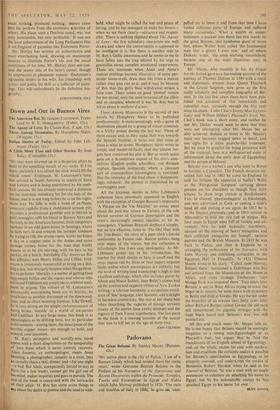Down and Out in Buenos Aires
The American Rat. By Jacques Lanzmann. Trans- (Wingate. 15s.)
Italian Stories of Today. Edited by John Leh- mann. (Faber, 16s.) 'al y toes were screwed up in a desperate effort to hold in the appalling stench of my socks. If I let
them unclench I was afraid the stink would fill the whole room.' Fridmann, M. Lanzmann's hero, has arrived in South America in search of fame and fortune and is being entertained by his snob- bish cousins. He has already embraced a domestic on the doorstep, mistaking her for the lady of the house, and it is not long before he is on his night- mare way. He falls in with a band of ex-Nazis, contracts syphilis from a clubfooted servant girl,
becomes a professional gambler rind is thrown in gaol, smuggles, sells his blood in Buenos Aires and his body to the American hospital, finds temporary harbour in an odd guest-house in Santiago, where he falls very ill and rewards the inmates' kindness by trying to rifle the strong-room, works ten hours a day in a copper mine in the Andes and saves passage money home for the boat that finally steams in as he sits starving, with his fare in his Pocket, on a beach. Inevitably The American Rat has affinities with Henry Miller and Celine. Frid- mann is immensely resourceful at living on a shil- ling a day, but strangely helpless when things threa- ten to go better. Morality is a matter of getting food into empty bellies and the rogues and whores who surround Fridmann are simply there,vvithout senti- ment or stigma. The virtues of M. Lanzmann's untowardly entertaining book are its brevity, its credibility as another document of the down-and- outs, and its often stunning humour. Like Orwell, he is very strong on the simple embarrassments of being broke, 'outside' in a world of tea-parties and Cadillacs. In any large sense, this book is as meaningless as its drifting hero, but its particular achievements—among them, the description of the terrible copper mines—are enough to hold, and reward, your attention.
M. Roy's perceptive and worldly-wise novel opens with a short disquisition on the temporality of love from which it never entirely recovers. Alain Josseret, an anthropologist, meets Anna Hessling, a photographer, casually in a train, they as casually share a taxi, dinner, and—for one night --a bed. But Alain, unexpectedly forced to stay in Paris for a few weeks, cannot get the girl out of his mind, makes inquiries and goes in pursuit. The rest of the hook is concerned with the intricacies of their affair. M. Roy has some acute things to hay about the desire to possess and the need to with- hold, what might be called the war and peace of loving, and he has managed to make his lovers— when we see them clearly—attractive and respon- sible. There is nothing slipshod about The Agony of Lore: the few subsidiary characters are well drawn and where the conversation is supposed to be intelligent it is. But there is another side to M. Roy's Gallic awareness and he seems to me to have fallen into the trap offered by his urge to generalise about complex emotional experiences. There are moments when Alain and Anna's mutual probings become illustrative' of some par- ticular home-truth, draw their life from a maxim rather than give rise to it: and it may be because of this that the girl's final withdrawal strikes a false note, There seems no good 'plotted' reason for her denial, only the need to round off the affair and so complete whatever it was M. Roy had to tell us about le malheur d'aimer.
Three Among Mountains is the second of two novels by Humphrey Slater to be published posthumously. It starts arrestingly with a game of slapbottom played by a group of minor criminals in a Vichy prison during the last war. Three of them escape and, as they make their way towards the Spanish frontier, it turns out that none of them is what he seems. Humphrey Slater wrote so simply and matter-of-factly that one almost for- gets how contrived his plot is. But so much space goes on a Koestlerian exposé of his trio's ante- cedents (English public schoolboy, red Russian orphan, Spanish aristocrat), where a pleasant sort of cosmopolitan knowingness is exercised, that the interplay of the final chase is disappoint- ingly subdued : the present is diminished by an overweighty past.
All the fourteen stories in John Lehmann's collection have previously appeared in English with the exception of Giorgio Bassani's impressive 'A Plaque on the Via Mazzini,' an ironic piece about the post-war return to Ferrara of the sole Jewish survivor of German deportation and the town's increasingly uneasy reaction to his in- transigence. Vitaliano Brancati deploys a .simpler, but no less effective, irony in 'The Old Man with the Top-Boots,' the story of a poor clerk's forced conformity to Fascist rule. Recent politics hang over many of the stories, but the collection is refreshingly free from easy apologetics. As Mr. Lehmann points out in his introduction, the market for short stories in Italy is small and the
terza paging run by three or four papers imposes limits within which masterpieces arc unlikely; but
the level of writing (and translating) is high in this excellent anthology, which also includes pieces by Silone and Mario Soldati. Jean Boley's stories had
all the positive and negative virtues of New Yorker
writing: a tolerant humanity, a scrupulous avoid- ance of 'fine' language, alert humour, and a delight in harmless eccentricity. She was at her sharp best when describing the vagaries of foreign servants (many of the stories have exotic settings) and the rigours of Park Forest togetherness. The last piece in the book is a moving account of the cancer that was to kill her at the age of forty-two.
JOHN COLEMAN






































 Previous page
Previous page